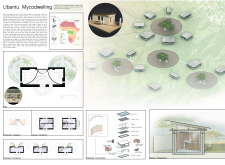5 key facts about this project
The architectural design features a series of circular arrangements that facilitate communal living while allowing for privacy. Each unit is adaptable, catering to various lifestyles and needs. Central communal spaces are integrated into the design, fostering social engagement among residents. The use of circular forms reflects traditional African architecture, while contemporary materials and techniques infuse the design with durability and modernity.
Sustainability is a core principle of the Ubantu Mycodwelling project. The selected materials include metal roofs for effective rainwater harvesting, locally sourced wooden purlins, bamboo for structural support, and concrete beams for stability. Earthen materials are utilized for walls, emphasizing thermal performance and ecological design. This careful selection minimizes the environmental impact and aligns with local building traditions, making the project contextually appropriate.
The unique aspect of the Ubantu Mycodwelling design lies in its emphasis on community interaction through spatial organization. By prioritizing flexibility in dwelling configurations, the project encourages residents to engage with one another while maintaining personal space. This design approach aims to cultivate a sense of belonging and interconnectedness, which is often missing in modern urban developments.
Moreover, the integration of green spaces within the architecture enhances both ecological value and livability. The design not only aims to provide shelter but also creates an environment conducive to social exchange and community support. This focus on collaboration and shared resources marks a significant divergence from conventional residential projects, which often prioritize individualism over community.
For further insights into the architectural plans, sections, designs, and ideas behind the Ubantu Mycodwelling project, please explore the detailed project presentation. This exploration will unearth the innovative spatial arrangements and material choices that define this noteworthy architectural initiative.























